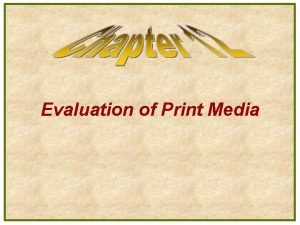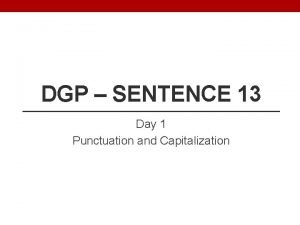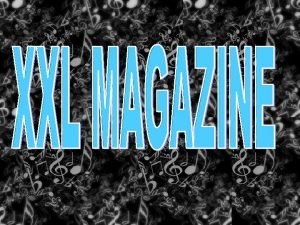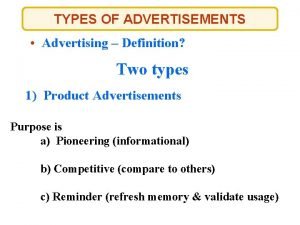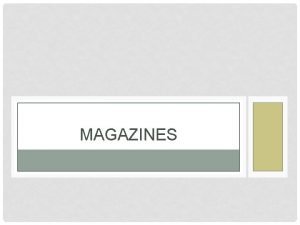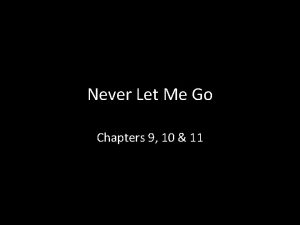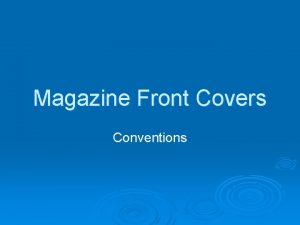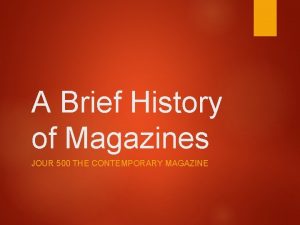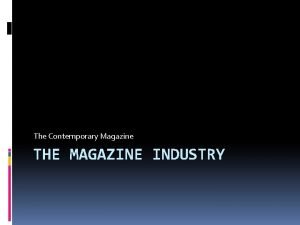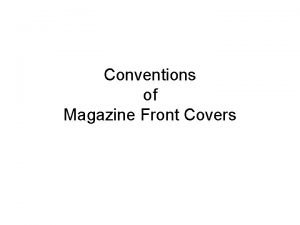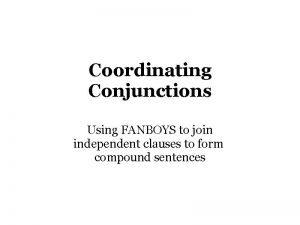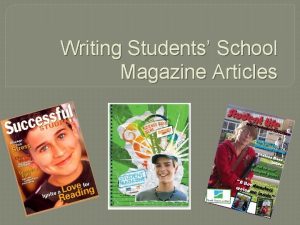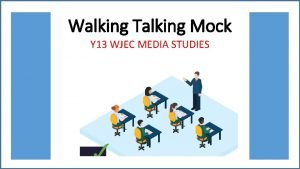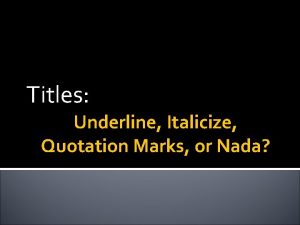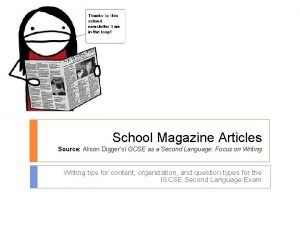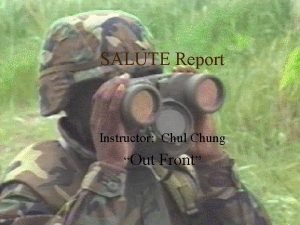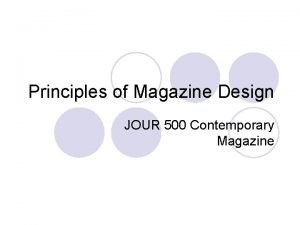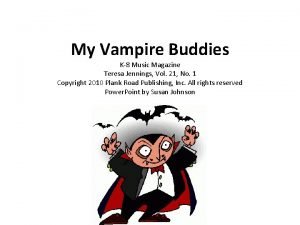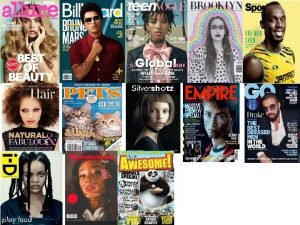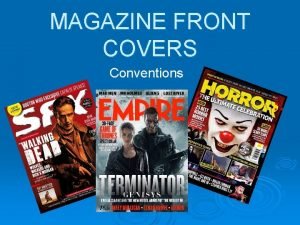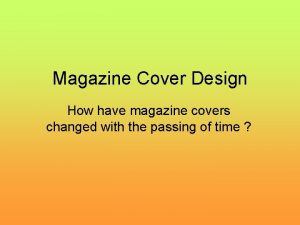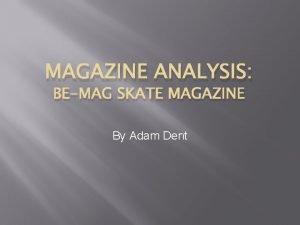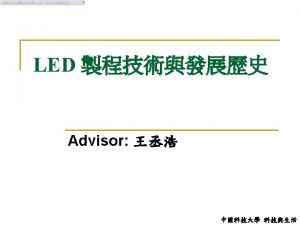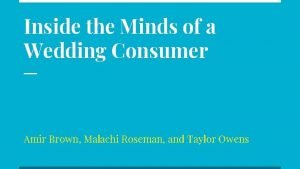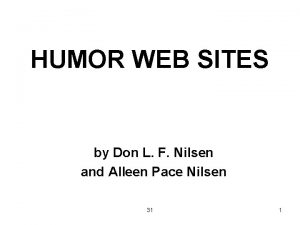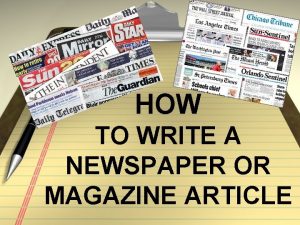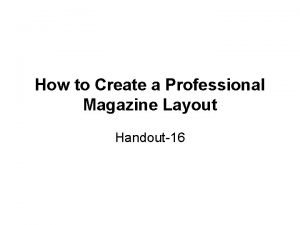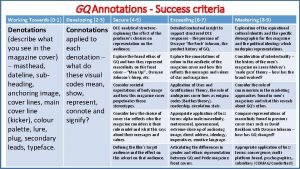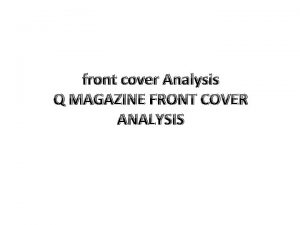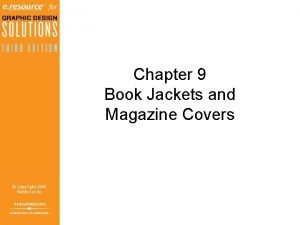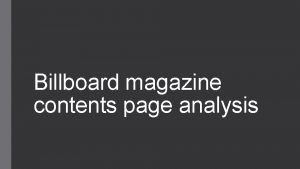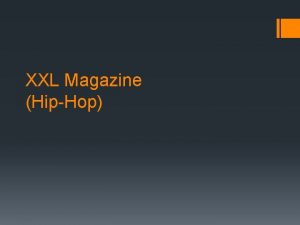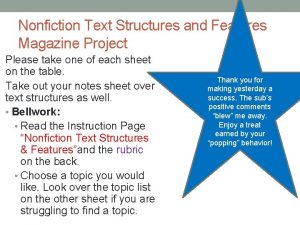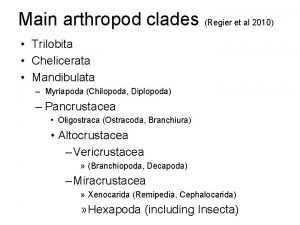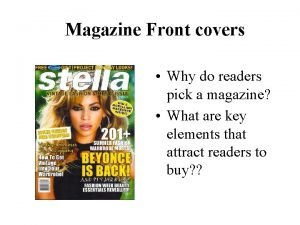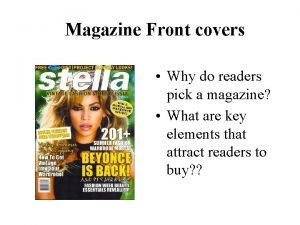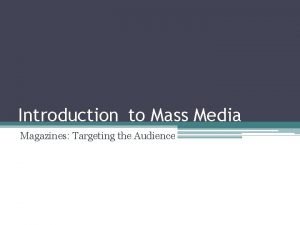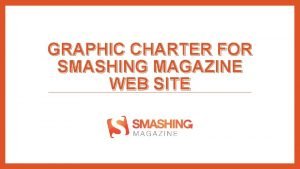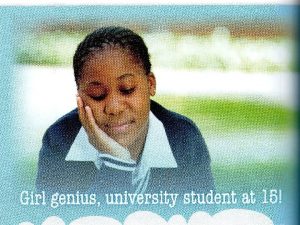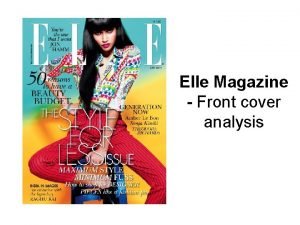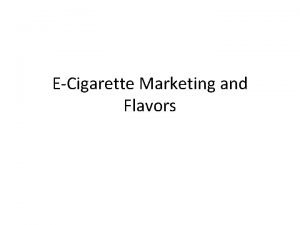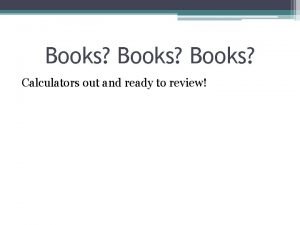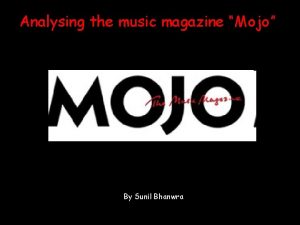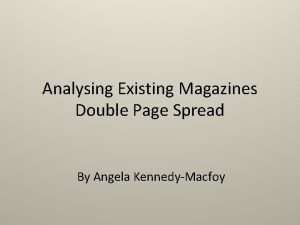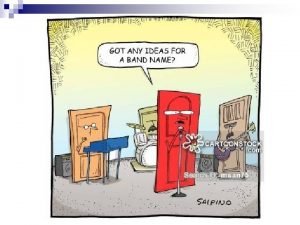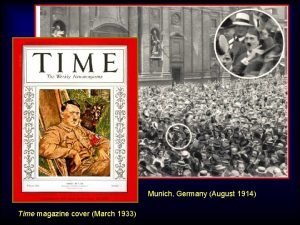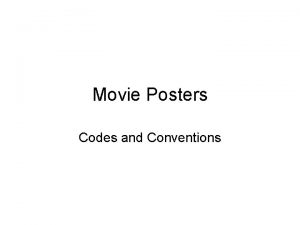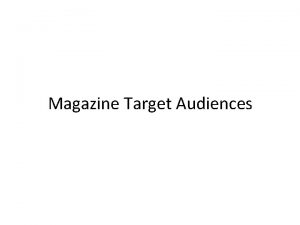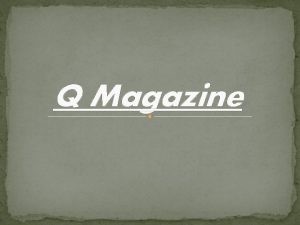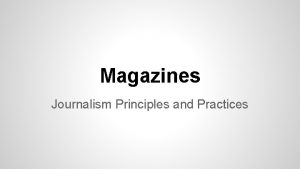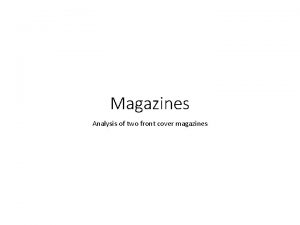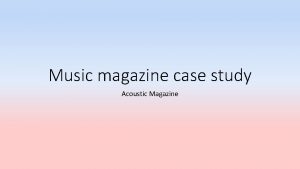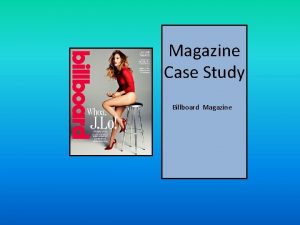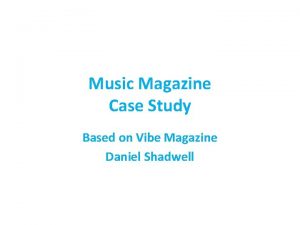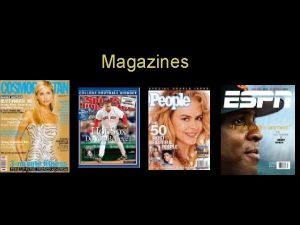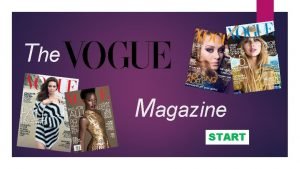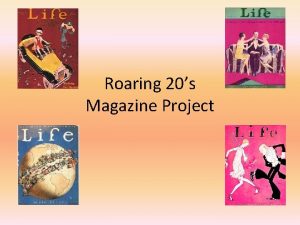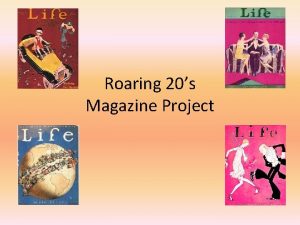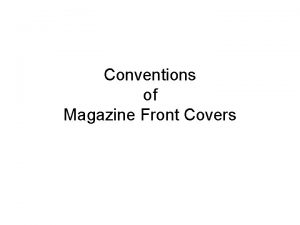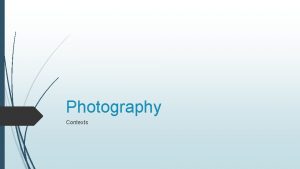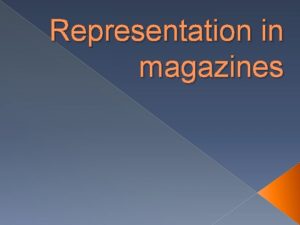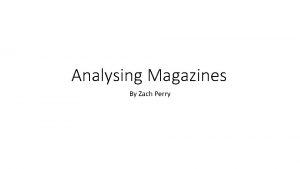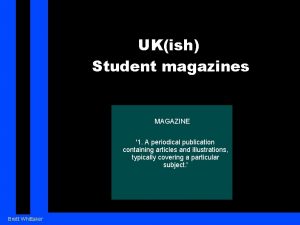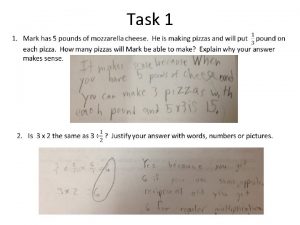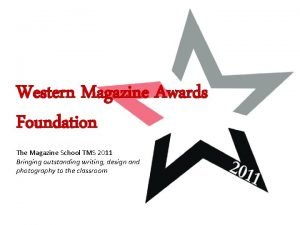Magazines Independent Study What is a magazine TASK






































































- Slides: 70

Magazines Independent Study


What is a magazine? TASK: Brainstorm conventions. Think about: • What they look like • What they contain • Who buys them

List as many magazines as you can think of • Read the Different kinds of magazines handout • Try to sort your magazine titles under the headings from the handout • Do they all fit? Why?

Mizz • Use the terminology grid to work out the meaning of the terminology then label your copy of Mizz • Put a title on your sheet saying Magazine Terminology

Masthead White writing on a black background coverline Contents in top left and/or right corners of cover The title of the magazine Pug or Ear Reverse block puff A short phrase to say how great the magazine is The titles of articles on the front cover Can you match the definition to the correct terminology?

Magazine Terminology Masthead = the title of a magazine Coverline = the title of articles on the cover Insert image – an extra image on the cover, presented in a box/bordered shape Puff = a short phrase to say how great the magazine is Pug or Ear – the content in the top corners of the cover Reverse Block = white writing on a black background

Vogue - Analysis In pairs analyse the way that the front cover works on Vogue. Look at: • Image • Coverlines • Colours • Fonts • Layout • Use the Magazine Cover Analysis sheet on Weebly if you are struggling


Homework • Find a front cover of a magazine, or use one of the examples on Weebly (except for Vogue), and analyse. • Use the magazine cover analysis sheet to help you. • This work will go in your folder so as with your posters make it as detailed as possible

Pug/Ear Puff Masthead 3 4 1 7. How many colours are used for the text on the cover? Why? 8 What techniques are used in the language and images to attract an audience? Insert image 5 6 Main image 2 coverline

Analysing contents pages Look at a contents page and try to answer these questions. The questions get gradually harder and will reflect your level of analysis. Remember that the examiner won't know your questions so answer in full sentences. D grade - answer questions 1 -4 C/B grade - answer questions 1 -6 A/A* grade answer questions 1 -7 1. How many contents headings are there? List them 2. How many articles are referred to under each heading? 3. Work out the number of pages devoted to each main content heading. 4. Is there anything under the title of each article on the contents page? Why is that there? 5. Look at the cover of the magazine and which content items are highlighted. What do these aspects tell you about the messages that the magazine promotes? Does it suggest anything about the target audience in terms of: age gender professional class 6. The contents page will often indicate which articles are the ‘regular’ items that appear in every issue and what are the ‘feature’ articles that only appear in this issue. Try to identify which are features and which are regulars 7. Pick out some of the language used in the contents page which is there to attract the audience – what techniques are used?

Editorial pages • What is an editor? • What is an editorial? • An editorial is a column written by an editor which introduces the magazine for this issue

• Look at these examples of editorials and come up with a list of what editorials do

Editorials Tend to: Be informal/ treat the reader like a friend Include images Read like a letter Speak directly to the reader Point the reader towards special features in the magazine • Include special offers/competitions • • •

Analysis • Choose one contents page and one editorial of your own and analyse/annotate • There are documents on Weebly to guide you through your analysis if you need it • EXTENSION – analyse a second contents/editorial page

What is the log? • For this unit, you have to hand in a production log with your work. This is a kind of analytical diary of the work that you have completed E grade C grade Some notes describing Notes explain clearly what you have done in the lesson with some reflection on how successful you have been and some analysis of what you have done A grade Detailed analysis of work achieved, with explanations of why/how work was created in this way

Example • Sample blog • Sample log • Your work will be in Word, but you should include screenshots of all the work that you have done, or scans/photos of it into your Word document • You will also include the actual documents at the end of your folder

The log • At the end of every lesson you must clearly state what work you have completed • This document is used as evidence of the work that you have done and when it is completed. • Time management is part of this assessment, so you must evidence your use of time E C A Time management may not be good Time management is excellent

Monitoring • Your teachers will monitor your production logs to ensure you are progressing well and completing the work accurately • Your log will be saved on your google drive

Starting your log • November 27 th Analysing front covers in class • December 1 st Homework – write up the homework that you have done


Analysing contents pages Look at a contents page and try to answer these questions. The questions get gradually harder and will reflect your level of analysis. Remember that the examiner won't know your questions so answer in full sentences. D grade - answer questions 1 -3 C/B grade - answer questions 1 -5 A/A* grade answer questions 1 -6 1. How many contents headings are there? List them 2. How many articles are referred to under each heading? 3. Is there anything under the title of each article on the contents page? Why is that there? 4. Look at the cover of the magazine and which content items are highlighted. What do these aspects tell you about the messages that the magazine promotes? Does it suggest anything about the target audience in terms of: age gender professional class 5. The contents page will often indicate which articles are the ‘regular’ items that appear in every issue and what are the ‘feature’ articles that only appear in this issue. Try to identify which are features and which are regulars 6. Pick out some of the language used in the contents page which is there to attract the audience – what techniques are used?

Extension work • If you have finished, complete the analysis task again for another magazine contents page. There are examples on Weebly

Language use in contents pages • How is language used in this contents page

Analysing double page spreads

Double Page article analysis REMEMBER to write the title before you start your work and write down the magazine and article that you are analysing. LANGUAGE 5. What type of language is used in the headlines? · Give a quote and analyse Answer the following questions in detail. 6. What type of language is used in the Remember that the moderator will not see these questions so make sure your answers make sense. subheading? · Give a quote and analyse 7. Choose 4 quotes from the main copy and PRESENTATION 1. How are the headlines presented? analyse the use of language in each one · Font separately. Choose examples of different types of · Colour language use. For example: · Position · Slang/colloquial language · Size · Imperatives "Go to the pool and …" 2. How is the copy presented? · Alliteration or sibilance "Fun, fantastic fashion · Font for the fit female" · Colour · Humour · Position · Rhetorical questions "Why are all men stupid? " · Percentage of page · Chatting directly to the reader "Anyway I'm sure 3. How are the images presented? you are desperate for me to get to the real · Colour point…" · Position 8. Do you notice anything else about the · Percentage of page language? · Denotation and connotation of images 4. What do you notice about the overall layout of the article?

Layout • In chunks – each section separated by numbers - makes it easy to access for the reader • In columns - typical of magazines • Use of three images spread across the two pages - Makes it appealing to the audience • Large headline - makes the story clear to the audience

Headline • 3 different colours • All in capital letters • 12 is very large • Ellipsis • Exclamation mark

Images • Robbie – cool, all in black, dancing – the text in reverse block confirms the argument of the article • Subbuteo man = girls’ stereotypical idea of ‘pointless game’ • Air guitar image – stereotypical reason to ridicule someone

Language Direct address – makes it seem like the mag is talking directly to the reader Slang – we use slang with our friends so it makes the mag seem like your friend

Grading Grade Exam Board mark scheme What this means U–G Minimal research Some labelling of real magazines F–D Basic Research Basic annotations F – two comments E – 3 comments D – 4 comments with some analysis (connection to audience) C–B Proficient Research Annotations including terminology and each point has analysis relating to the reader (at least 5 comments) A–A Excellent Research Detailed and thorough analysis including terminology. Specific analysis of language included

Brainstorming • Brainstorm ideas for your magazine • Decide who your target audience is going to be and brainstorm what you might include in your magazine. Remember that you will have to take photographs YOURSELF to put in your magazine E C A A simple brainstorm with 5 or 6 ideas A detailed brainstorm with 10+ideas with some explanation of the ideas A detailed brainstorm with 10+ideas with clear explanation of the ideas, including some images Now write up this work in your production log

Industry Research Task B – A* Grades – see extension D-B GRADES work on Weebly Specific Audience Your magazine must be made for a specific audience. It can’t be made for ‘everyone’. You need to think about different audiences and what kind of content might be in the magazine. There always exceptions – boys sometimes read girls’ magazines, but the mag will still be targeted at teenage girls- TASK: Your Magazine • Think about the genre of magazine that you might like to make and the target audience. • Research the range of titles currently published for your target audience. Produce a collage of front covers • Which of these magazines is the most popular? • Why do you think this?

Primary Audience Research • What does primary research mean? Research that you have conducted yourself by directly contacting your audience • What does secondary research mean? You read other people’s research (on the internet/ in books/ in newspapers etc) and use that to give you information about your audience

Primary Audience Research • Now it is time to do your own research – use the document on Weebly to choose the task that is most relevant to your level and target Now write up your primary audience research in your log

Conduct the questionnaire • Conduct your questionnaire with at least 10 people from your target audience • Analyse the results (Excel/ paragraph to show understanding) EXTENSION: Complete the Audience Research Task on Weebly

Plagiarism • Handing in coursework that is not your own is cheating • You will be disqualified if the moderator finds work in your folder that is not yours • You run the risk of being disqualified from ALL GCSEs in this session

Planning • Remember that this must be all your own work. You cannot take any of the article from real articles in magazines or on the internet and the images MUST be images you have taken yourself. However, you can imagine that your friend is a famous footballer and write an interview with them. You shouldn't interview them, but should make up the text of the interview yourself. • The examiner will not be impressed by silly comments that look like teenagers trying to impress their mates!

Planning – the article • Brainstorm what your double page spread article will be about – make sure that it is neat to go in your folder • Mock up your article • Write the text of the article in Word without layout decisions See the document on Weebly – planning your double page spread article Now write up your article planning in your log

Mock up


The contents page • Your contents page can be single or a double page spread • If you choose a double page spread it should include an editorial • Use your brainstorm sheet to think of ideas for articles in your contents page

Reminder: Language use 1 2 3 4 5 6 This sheet should be in your folder – use it to help you in the creation of your contents page

TASK • In Word, plan the text for the contents page for your magazine. Do not consider the font, colour or layout at this stage, just the text to be used in your magazine E grade C grade A grade • 10 article headlines • 20 article headlines • some subheadings • some creative use of language • 30+ article headlines • subheadings for most • Language used in a range of creative ways

Sample Readers’ Stories 14 Nasty Knitter My ‘friend’ sent messages knitted into scarves 26 Nifty Needles I won the title of fastest knitter in Berkshire 48 Pull the wool over his eyes How I kept knitting to hide my affair

Sample Patterns for Winter 6 Scrumptious Scarves Lightweight scarves for extra style 62 Do you do diamonds? Classic diamond knit socks for that special Xmas present • etc

Numbers in order but not consecutive Subject sections Readers’ Stories 14 Nasty Knitter My ‘friend’ sent messages knitted into scarves 26 Nifty Needles I won the title of fastest knitter in Berkshire 48 Pull the wool over his eyes Language use How I kept knitting to hide my affair • Alliteration • Rhyme Patterns for Winter • Pun • Rhetorical 6 Scrumptious Scarves question Lightweight scarves for extra style • triplets 62 Do you do diamonds? Classic diamond knit socks for that special Xmas present • etc

Extension • If you have finished, first check that you have been as creative as possible with your language use • Then consider the layout of your contents page. Think about use of images, colour, blocking, titling, position of your editorial etc. • For a B-A* grade, you should aim to create a double page spread for your contents page • Draw the mock up of your page/s on A 4 paper

Planning your front cover Points to remember • Should have a big image which takes up most of the page • Needs a masthead • Needs at least 5 coverlines • Needs barcode, date, price, puff

Mock up • Draw a detailed mock up of your cover with • all of the coverlines • a description of your image • decisions about colours

Planning your images • Remember that you need to keep all of the unmanipulated images that you have taken for your work • Remember that the images cannot appear anywhere else on the internet (don’t post the images you take for your work onto Facebook!)

Planning your masthead • Consider the layout of your masthead. Choose a real magazine to base your masthead on so that it looks professional. • Show the real masthead/s and your decision • Consider the colour/ font/ layout • Write bullet points or a short paragraph to explain your reasons

Include a title Masthead Designs Include annotations as to why you have chosen/ not chosen some of your designs Access this planning sheet on Weebly • Decide the name of your magazine • Choose a real magazine to base your masthead on • Try out different fonts and colours • Use dafont or other font websites • Avoid Word Art fonts with a gradient colour • Your masthead should be a banner across the whole of your front cover

Masthead design - marks A B C D or below Planning of masthead design clearly shown, analytical annotations as to why particular designs were rejected and why one was chosen. Font, colour and layout decided Planning of masthead clearly shown, annotations as to why particular designs were rejected and why one was chosen. Font, colour and layout decided Planning of Included masthead shown, some annotation as to why particular designs were rejected and why one was chosen. Font, colour and layout decided

Making your article Use your mock up to make your real article on Publisher. Copy and paste the Word planning of your article into the text boxes on Publisher Points to remember • Try to include lots of images • Make sure all text is in columns – use the link text box tool to allow you to adjust column sizes • Font size of body copy should not be more than 12 Use the Construction – Mark your Own sheet on Weebly for grading

Check • All unmanipulated, original photos printed on A 4 in colour to go in your folder. Fit at least 6 photos per page (Title: Unmanipulated Images)

Task • Create your contents page in Publisher • Use your mock up for the layout • Copy and paste the contents that you have written in Word into the separate text boxes Remember • Lots of images • Max 12 for font size for copy Use the Construction – Mark your Own sheet on Weebly for grading

Task • Make your front cover in Publisher • Use your mock up and your masthead design to help • Make sure your main image is large and well framed • What does ‘well framed’ mean? • The model is positioned in a sensible position within the whole of the photograph

Images • Front cover image should be large • Shouldn’t be enlarged unless on high pixel ratio camera because makes them pixelated • Lighting should be bright on the subject (not behind them). • If your camera has the function –set the white balance – see instruction booklet! • Front cover image – leave enough space above the model to place the masthead • Outside images shouldn’t be at night • Take a portrait image for your cover (not landscape)

Conventions Why is this cover less successful?

Conventions • Put images into Photoshop and play with the colour/ contrast effects to improve your photos • Get eye contact with your audience • Large masthead • Large coverlines • 3 colours for coverlines • No white empty space • Small font for main text


Framing DON’T DO THIS!

Things to remember Large masthead Large image in sharp focus Background is blurred or plain and usually light colour Limited colour scheme – 4 colours max, but usually only 3 Some font variety in coverlines Coverlines do not go over the face Coverlines on both sides of the page

Use mark your own sheets on Weebly (under mark schemes) A-A* B Use of IT Excellent use of IT so that the magazine looks like a professional magazine. Careful attention to detail. Images are cropped, resized and manipulated as appropriate. Excellent use of IT so that the magazine looks Very good use of IT. A lot of images are almost like a professional magazine. Attention cropped, resized and manipulated as to detail. Most images are cropped, resized and appropriate. manipulated as appropriate. Font A variety of font sizes and types are used. The font size for the articles is quite small and is generally size 12. A variety of font sizes and types used. Some variety of font size and type. The font size use in the text is too big and The font size for the articles is quite small and is Font size for double page spread article or looks unprofessional. Font size may be too generally size 12. other articles may be too big (over size 12). big in order to disguise the fact that the pupil has not written a lot (this does not work!). The font is more or less the same throughout– may have used times new roman throughout. Spelling No spelling or grammatical errors. The language takes into account the target audience No spelling or grammatical errors. The language Contains a few spelling or grammatical takes into account the target audience. errors. May contain poor punctuation. Contains a lot of spelling or grammatical errors. May contain word omissions or poor punctuation. Photographs Images are cropped appropriately. Images are sharp and clear in focus. In particular the image on the front cover is in focus. All images are pupils’ own. Images are cropped appropriately. The majority of images are sharp and clear in focus. In particular the image on the front cover is good. The majority of images are pupils’ own. Some Images are cropped appropriately. Most images are sharp and clear in focus. Some images are not the pupils own and have been taken from a website. Some images are in focus. Some images are not the pupils own and have been taken from a website. Photographs A variety of shot distances are used (exclose up, close-up, mid shot, long shot. ) Images and text are integrated professionally. Has selected appropriate mise-en-scene including colour, lighting, objects and setting. Careful attention to detail. A variety of shot distances are used. Images and text are integrated well. Some variety of shot distances are used. Images will be placed on the page with some integration with text. Has selected some appropriate mise-enscene including colour, lighting, objects and setting Images are just placed on the page with no real thought or effort. Mise-en-scene 4/5 Pages All 5 pages are produced to an excellent / Cover professional standard. Contents/ Editorial Double Pg Spread (2 pages) Has selected appropriate mise-en-scene including colour, lighting, objects and setting All 4/5 pages are produced to a very high standard. C All 4 pages are produced to a good standard. D or below Average use of IT. Very little manipulation of images. Mise-en-scene has been considered to a basic standard All 4 pages are produced to a basic standard. Work is rushed, unfinished and contains a lot of empty white spaces. May lack professional finish (ex-it may EVERY PAGE MUST BE INCLUDED OR THE contain empty white spaces, may not have WORK WILL NOT MEET THE REQUIRMENT page numbers, may have used images OF THE BRIEF. copied from the internet)

Writing your evaluation • Before you start your evaluation, you need to gather some audience feedback. Ask other people (from your target audience) to look at your work and give you some comments –both positive and negative. • You need to write an evaluation for your portfolio. The evaluation should be between 500 – 800 words long and it should be word-processed. Your brief and the title of your production should be stated clearly as the heading of your evaluation • As you write, aim to analyse and evaluate throughout. Do not repeat anything (eg if a bullet points are similar and you have already answered the point, don’t write it again) and always say WHY you did something, not just that you did it. DON’T MOAN! The examiner will not respect your work if it just moans about the software etc!

3 sections RESEARCH AND PLANNING • Explain what research you did and what you learned (real magazines and audience research) • Explain what planning you did and why it was helpful CONSTRUCTION • Explain how you made your pages and WHY you made them in that way EVALUATION • Explain what audience feedback you got • Say if you agree or disagree with their opinions and explain why • Analyse your final pages, explaining the connotations created. (eg why you used certain colours, fonts, images, words etc)

Mark Scheme – on Weebly Level 4 (24– 30 marks) A* A B C D E F G U 27 24 22 18 15 12 9 6 0 • There is a detailed evaluation of the monitoring of decisions and revisions. • There is a detailed discussion of how the brief related to research into similar media texts and target audiences. • There is excellent understanding of the forms and conventions used in the production. • There is excellent understanding of the significance of audience feedback. • There is excellent ability to communicate. • There is a thorough evaluation of the success of the finished media text in meeting the original brief. • There is an accurate command of appropriate medium-specific terminology.

Ticklist • Use the ticklist on Weebly to ensure that everything is in your folder in the right order
 Anime missionary hentai
Anime missionary hentai Classification of magazine
Classification of magazine She should have thrown out those magazines
She should have thrown out those magazines Xxl magazine awards
Xxl magazine awards Articles to write in school magazine
Articles to write in school magazine What are the two types of advertising?
What are the two types of advertising? Reading to gain knowledge
Reading to gain knowledge Never let me go quotes
Never let me go quotes Magazine front cover conventions
Magazine front cover conventions Brief history of magazines
Brief history of magazines Contemporary magazine
Contemporary magazine Strapline magazine
Strapline magazine Tiered task bias task
Tiered task bias task Independent clause fanboys independent clause
Independent clause fanboys independent clause Rolling stone magazine 1967
Rolling stone magazine 1967 Task 2 study the advertisement
Task 2 study the advertisement Study the advertisement
Study the advertisement Ecological study vs cohort study
Ecological study vs cohort study Retrospective cohort study
Retrospective cohort study Critical examination in method study
Critical examination in method study Marty lobdell
Marty lobdell Study to study
Study to study Distinguish between motion study and time study
Distinguish between motion study and time study Difference between time study and motion study
Difference between time study and motion study Write a letter to your school magazine
Write a letter to your school magazine Uhmt
Uhmt Pride magazine media studies
Pride magazine media studies Grihalakshmi magazine march 2019
Grihalakshmi magazine march 2019 Graduate success attributes magazine
Graduate success attributes magazine Quotation marks for titles
Quotation marks for titles Time magazine new face of america
Time magazine new face of america School magazine cover
School magazine cover Article for school magazine
Article for school magazine Acronym salute
Acronym salute Magazine cover design
Magazine cover design Paragraph my school magazine
Paragraph my school magazine K8 magazine
K8 magazine Dance moms seventeen magazine
Dance moms seventeen magazine Magazine cover tagline
Magazine cover tagline Magazine front cover conventions
Magazine front cover conventions Magazine front cover ideas
Magazine front cover ideas Skate magazine cover
Skate magazine cover Compound semiconductor magazine
Compound semiconductor magazine Elizabeth holmes fortune magazine
Elizabeth holmes fortune magazine Brides magazine targets consumers who are in
Brides magazine targets consumers who are in Mad magazine
Mad magazine Magazine article structure
Magazine article structure How to print a professional magazine
How to print a professional magazine Gq magazine target audience
Gq magazine target audience Q magazine front cover
Q magazine front cover Objectives of magazine
Objectives of magazine Content page magazine
Content page magazine Xxl publisher
Xxl publisher Magazine article format
Magazine article format Collembola
Collembola Main cover line magazine
Main cover line magazine Main cover line magazine
Main cover line magazine Cio magazine editor
Cio magazine editor Mass media magazine
Mass media magazine Smashingmagazine
Smashingmagazine Girl genius magazine
Girl genius magazine Magazine layout analysis
Magazine layout analysis Rolling stone magazine
Rolling stone magazine A magazine publisher mails a survey to every subscriber
A magazine publisher mails a survey to every subscriber Mojo magazine target audience
Mojo magazine target audience Gossip magazine double page spread
Gossip magazine double page spread A magazine reported that 6 of american drivers
A magazine reported that 6 of american drivers Rolling stone magazine
Rolling stone magazine Time magazine audience
Time magazine audience Conventions of a movie poster
Conventions of a movie poster Magazine target audience
Magazine target audience

